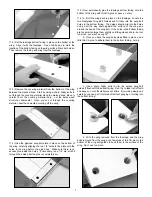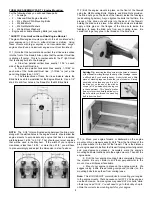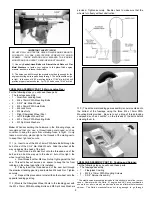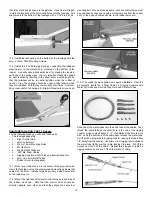
Note: The large control throws used in 3D flying require a servo
with precise centering capability. The new digital type servos have
outstanding centering characteristics and are highly recommended
for serious 3D flying. You can not expect this airplane to give you
optimum 3D performance using non-ball-bearing standard servos.
SERVO CHORDS NEEDED:
Ailerons - one standard y-harness
and
two 6” or two 12” servo extension chords
(depending upon the length of the pigtail wires on
your particular servos)
Elevator - one 24” servo extension chord
HEAVY-DUTY SERVO ARMS:
Larger than stock size servo arms are needed to achieve the large
3D control throws.
We recommend Du-Bro
®
"Super Strength"
Servo Arms, which are available to fit any brand of servo. They are
very strong and work well with this model.
ENGINE SELECTION:
Engine choices for the 3D MAYHEM are many. The MAYHEM has
been designed to perform well when using the recommended
engine sizes. Do not use an engine larger than recommended.
RECOMMENDED ENGINES:
.72 to .91 cu.in.
2-Stroke
.72 to 1.20 cu.in. 4-Stroke
Very Important: The 3D MAYHEM is designed for slow speed, high
torque aerobatics. It’s fantastic low speed maneuverability is the
result of light weight and very large control surfaces - which are
naturally prone to flutter if flown at excessive airspeeds. To avoid
problems, follow these carefully tested guidelines:
1) Do not use engines larger than recommended. Resist the
urge to overpower your 3D MAYHEM with larger engines, which
can cause balance and structural problems, and produce
excessive airspeed.
2) Do not use a propeller with more than 6 inch pitch. Keep the
airspeed of the MAYHEM down by using low pitch propellers.
3) Do not fly full throttle except during climbs of at least 10
degrees. Always throttle back when in a dive.
Ignoring these cautions will put your model at high risk for
catastrophic in-flight structural failure.
REQUIRED TOOLS:
For proper assembly, we suggest you have the following tools and
building materials available:
A selection of glues - thin, medium, and thick SIG CA, and
SIG Epoxy Glue (5-minute and 30-minute)
R
1
3D MAYHEM ARF ASSEMBLY MANUAL
INTRODUCTION:
Congratulations on your purchase of a SIG 3D MAYHEM ARF.
This is not your average R/C aerobatic flyer! Properly assembled,
powered and flown, the 3D MAYHEM can take you into the
exciting world of 3D aerobatic flying.
Generous wing area,
lightweight construction, and huge control surfaces with large
amounts of travel, enable the 3D MAYHEM to perform the extreme
3D maneuvers you've been reading about… hovering, harriers,
waterfalls, blenders… the 3D MAYHEM can do them all.
NOTE: The 3D MAYHEM is not suitable for beginners. While it is
a terrific flying airplane, it's neutral stability and quick controls are
beyond the capabilities of beginning R/C pilots. You should be
capable of flying low-wing, aileron equipped R/C models before
flying this airplane.
EASY TO ASSEMBLE:
The 3D MAYHEM ARF has been engineered to get you into the
air as quickly as possible with an R/C model that compares to the
best scratch-built airplanes.
The airframe has been expertly
constructed of the finest balsa and plywood available, then
professionally covered with tough Oracover
®
polyester film. The
airplane is both rugged and easy to repair.
This assembly manual has been sequenced to get your MAYHEM
assembled and into the air very quickly. We strongly suggest that
you read through the manual first to familiarize yourself with the
various parts and assembly sequences. The successful assembly
and flying of this airplane is your responsibility. If you deviate from
these instructions, you may wind-up with problems later on.
RADIO EQUIPMENT:
We highly recommend the use of a modern programmable
computer radio. Such radio systems allow you to easily set and
adjust every channel and additionally program various flight
functions to suit your individual style of flying.
The 3D MAYHEM requires a 4 (or more) channel radio system with
five servos.
SERVO REQUIREMENTS:
Ailerons - two (2) ball bearing servos with 70+ in/oz of torque
Elevator - one (1) ball bearing servo with 70+ in/oz of torque
Rudder - one (1) ball bearing servo with 90+ in/oz of torque
Throttle - one (1) standard servo
All servos are standard size dimensionally.


































